Wireless Networking Report: Cell Splitting, Design, and Analysis
VerifiedAdded on 2022/12/15
|11
|2061
|452
Report
AI Summary
This report delves into the intricacies of wireless networking, commencing with an explanation of cell splitting, a crucial technique for increasing capacity in congested areas by dividing larger cells into smaller ones. The report then addresses a practical scenario involving a new wireless service provider employing a 12-cell cluster, calculating the reuse distance, the number of simultaneous calls per cell, and the Erlang value, demonstrating an understanding of frequency reuse and traffic analysis. Finally, the report proposes cell designs with both small and large radii, explaining their distinct characteristics and the rationale behind their application, including considerations for power conveyance, scalability, frequency reuse, enhanced service grades, and cost reduction. The content leverages diagrams, formulas, and references to provide a comprehensive overview of wireless network design and performance analysis.
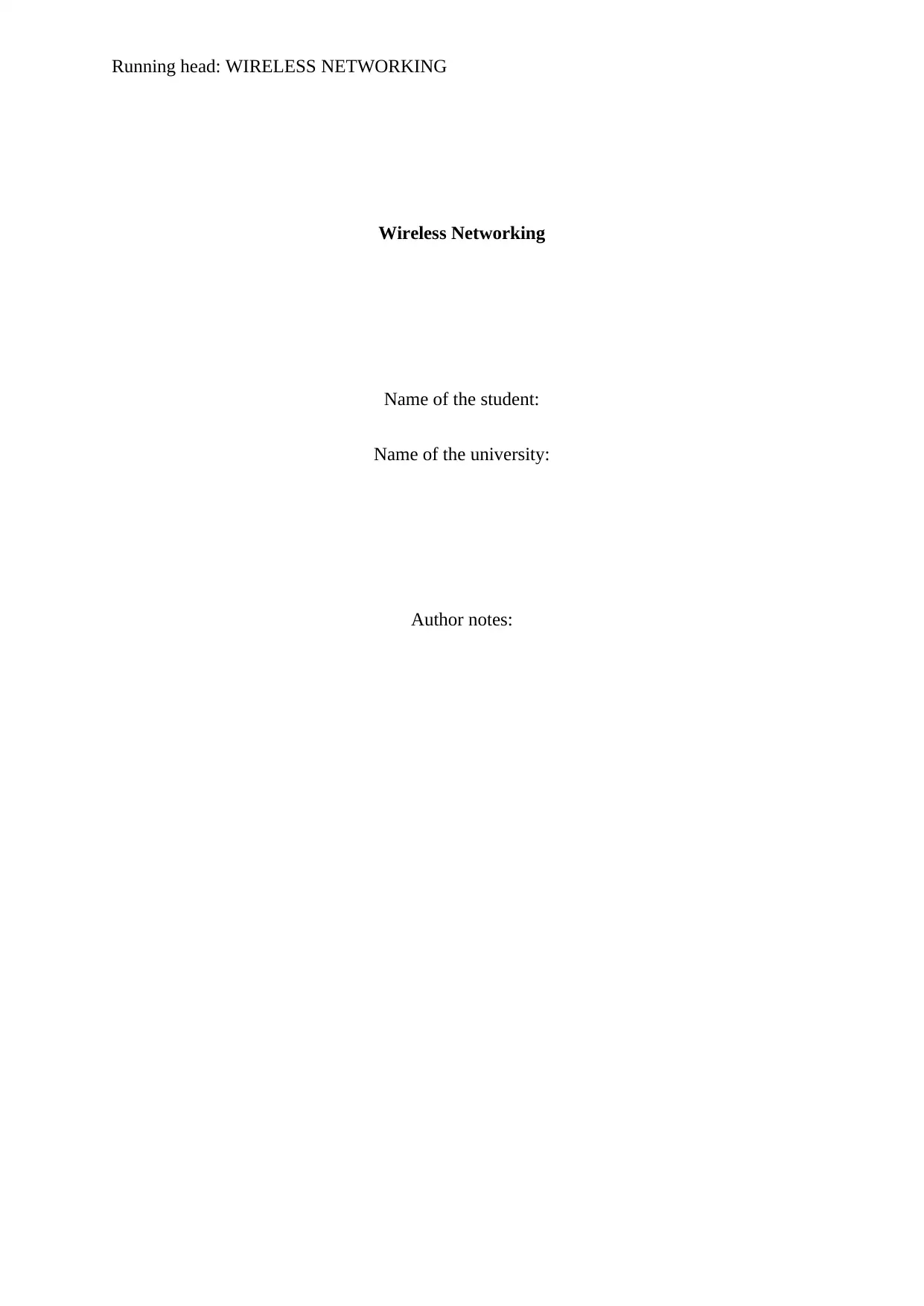
Running head: WIRELESS NETWORKING
Wireless Networking
Name of the student:
Name of the university:
Author notes:
Wireless Networking
Name of the student:
Name of the university:
Author notes:
Paraphrase This Document
Need a fresh take? Get an instant paraphrase of this document with our AI Paraphraser
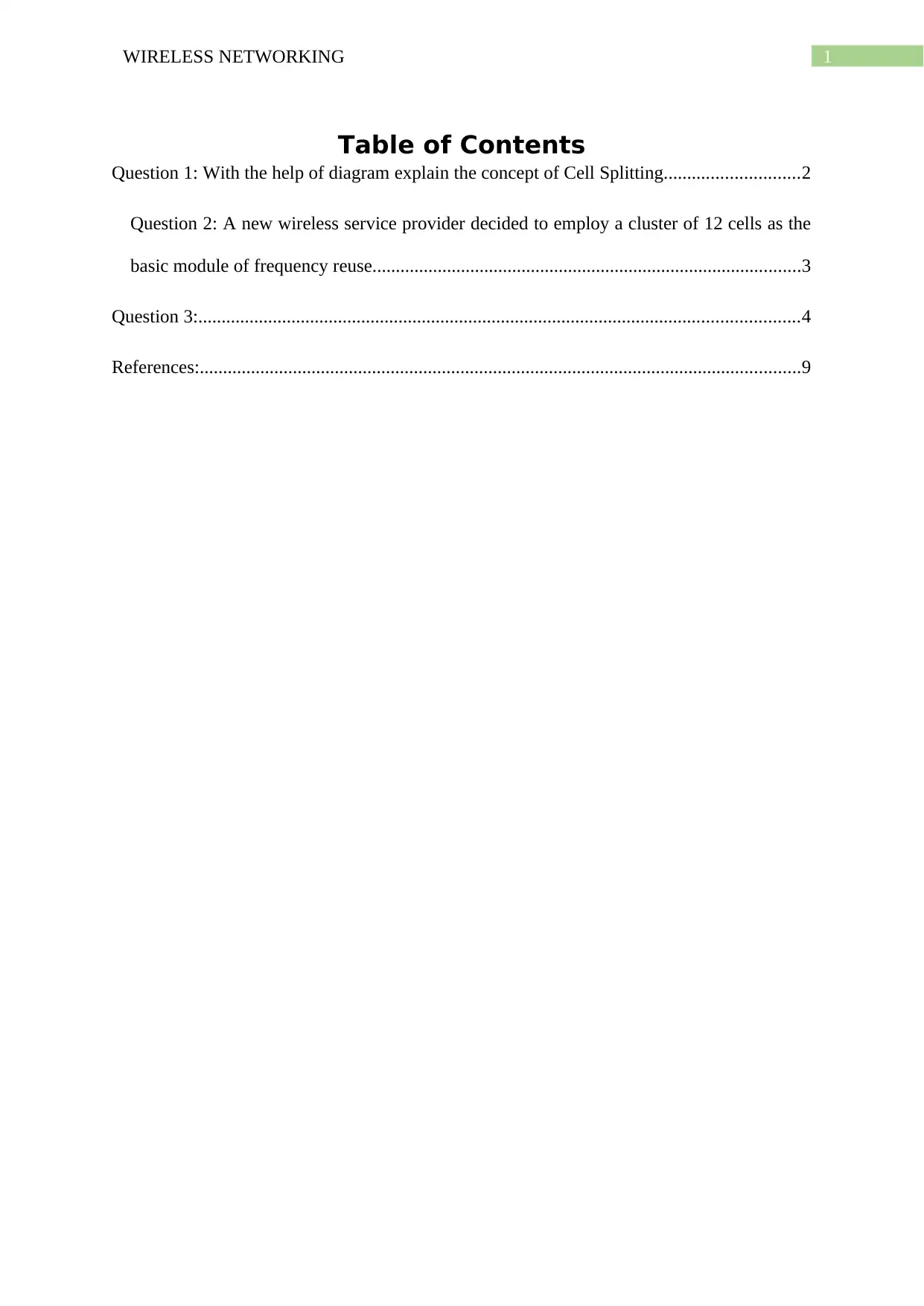
1WIRELESS NETWORKING
Table of Contents
Question 1: With the help of diagram explain the concept of Cell Splitting.............................2
Question 2: A new wireless service provider decided to employ a cluster of 12 cells as the
basic module of frequency reuse............................................................................................3
Question 3:.................................................................................................................................4
References:.................................................................................................................................9
Table of Contents
Question 1: With the help of diagram explain the concept of Cell Splitting.............................2
Question 2: A new wireless service provider decided to employ a cluster of 12 cells as the
basic module of frequency reuse............................................................................................3
Question 3:.................................................................................................................................4
References:.................................................................................................................................9
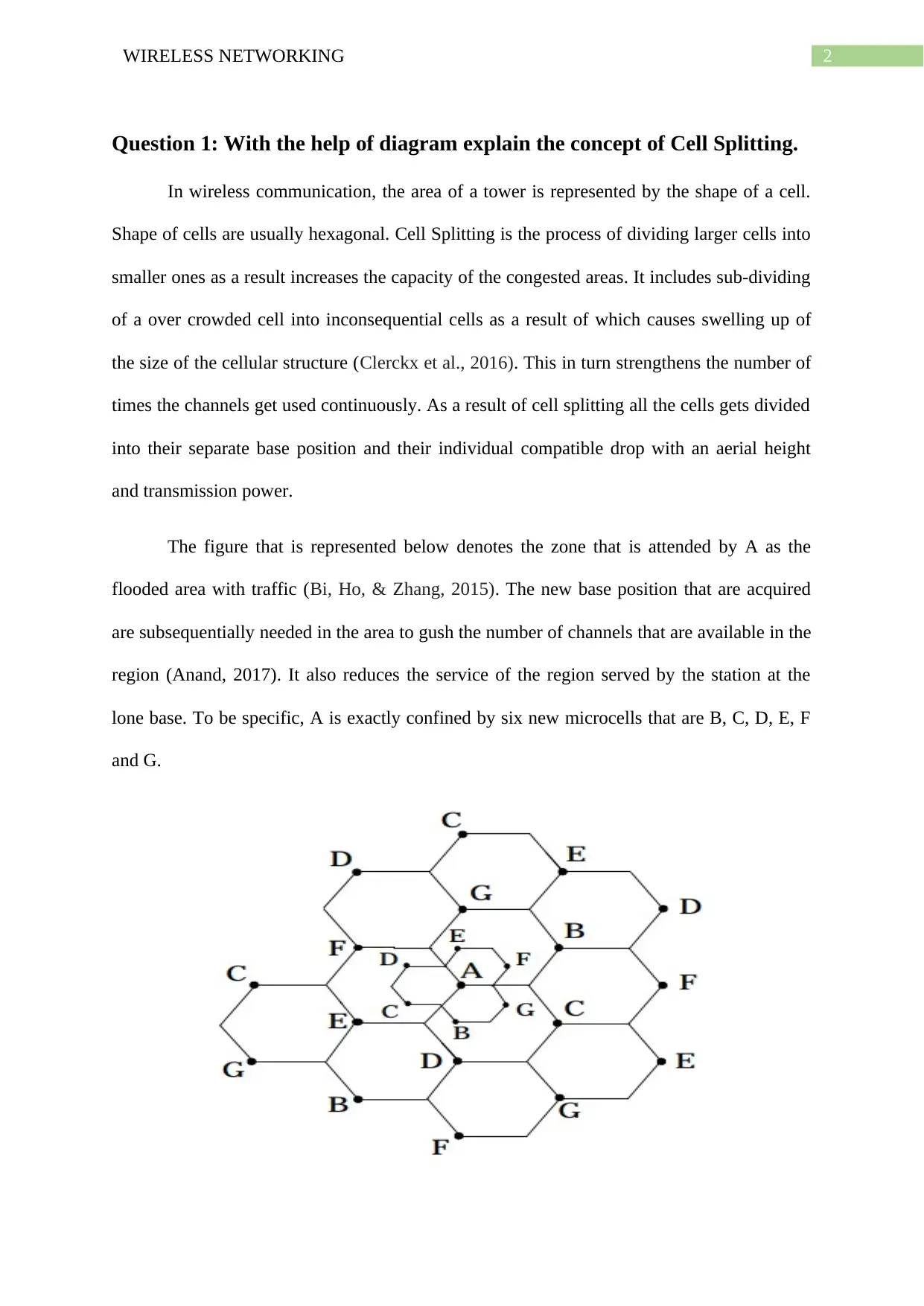
2WIRELESS NETWORKING
Question 1: With the help of diagram explain the concept of Cell Splitting.
In wireless communication, the area of a tower is represented by the shape of a cell.
Shape of cells are usually hexagonal. Cell Splitting is the process of dividing larger cells into
smaller ones as a result increases the capacity of the congested areas. It includes sub-dividing
of a over crowded cell into inconsequential cells as a result of which causes swelling up of
the size of the cellular structure (Clerckx et al., 2016). This in turn strengthens the number of
times the channels get used continuously. As a result of cell splitting all the cells gets divided
into their separate base position and their individual compatible drop with an aerial height
and transmission power.
The figure that is represented below denotes the zone that is attended by A as the
flooded area with traffic (Bi, Ho, & Zhang, 2015). The new base position that are acquired
are subsequentially needed in the area to gush the number of channels that are available in the
region (Anand, 2017). It also reduces the service of the region served by the station at the
lone base. To be specific, A is exactly confined by six new microcells that are B, C, D, E, F
and G.
Question 1: With the help of diagram explain the concept of Cell Splitting.
In wireless communication, the area of a tower is represented by the shape of a cell.
Shape of cells are usually hexagonal. Cell Splitting is the process of dividing larger cells into
smaller ones as a result increases the capacity of the congested areas. It includes sub-dividing
of a over crowded cell into inconsequential cells as a result of which causes swelling up of
the size of the cellular structure (Clerckx et al., 2016). This in turn strengthens the number of
times the channels get used continuously. As a result of cell splitting all the cells gets divided
into their separate base position and their individual compatible drop with an aerial height
and transmission power.
The figure that is represented below denotes the zone that is attended by A as the
flooded area with traffic (Bi, Ho, & Zhang, 2015). The new base position that are acquired
are subsequentially needed in the area to gush the number of channels that are available in the
region (Anand, 2017). It also reduces the service of the region served by the station at the
lone base. To be specific, A is exactly confined by six new microcells that are B, C, D, E, F
and G.
⊘ This is a preview!⊘
Do you want full access?
Subscribe today to unlock all pages.

Trusted by 1+ million students worldwide
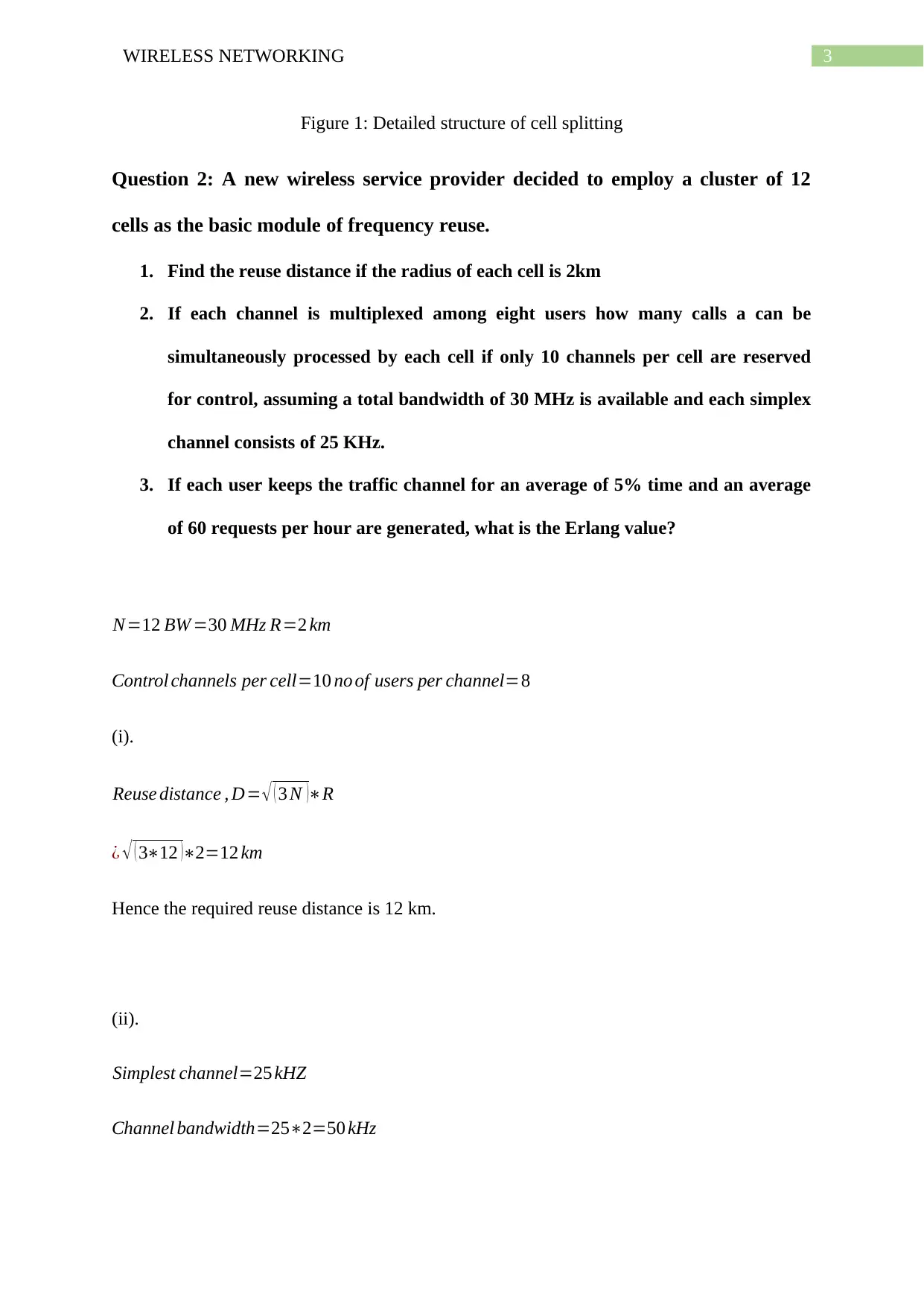
3WIRELESS NETWORKING
Figure 1: Detailed structure of cell splitting
Question 2: A new wireless service provider decided to employ a cluster of 12
cells as the basic module of frequency reuse.
1. Find the reuse distance if the radius of each cell is 2km
2. If each channel is multiplexed among eight users how many calls a can be
simultaneously processed by each cell if only 10 channels per cell are reserved
for control, assuming a total bandwidth of 30 MHz is available and each simplex
channel consists of 25 KHz.
3. If each user keeps the traffic channel for an average of 5% time and an average
of 60 requests per hour are generated, what is the Erlang value?
N=12 BW =30 MHz R=2 km
Control channels per cell=10 no of users per channel=8
(i).
Reuse distance , D= √ ( 3 N )∗R
¿ √ ( 3∗12 )∗2=12 km
Hence the required reuse distance is 12 km.
(ii).
Simplest channel=25 kHZ
Channel bandwidth=25∗2=50 kHz
Figure 1: Detailed structure of cell splitting
Question 2: A new wireless service provider decided to employ a cluster of 12
cells as the basic module of frequency reuse.
1. Find the reuse distance if the radius of each cell is 2km
2. If each channel is multiplexed among eight users how many calls a can be
simultaneously processed by each cell if only 10 channels per cell are reserved
for control, assuming a total bandwidth of 30 MHz is available and each simplex
channel consists of 25 KHz.
3. If each user keeps the traffic channel for an average of 5% time and an average
of 60 requests per hour are generated, what is the Erlang value?
N=12 BW =30 MHz R=2 km
Control channels per cell=10 no of users per channel=8
(i).
Reuse distance , D= √ ( 3 N )∗R
¿ √ ( 3∗12 )∗2=12 km
Hence the required reuse distance is 12 km.
(ii).
Simplest channel=25 kHZ
Channel bandwidth=25∗2=50 kHz
Paraphrase This Document
Need a fresh take? Get an instant paraphrase of this document with our AI Paraphraser
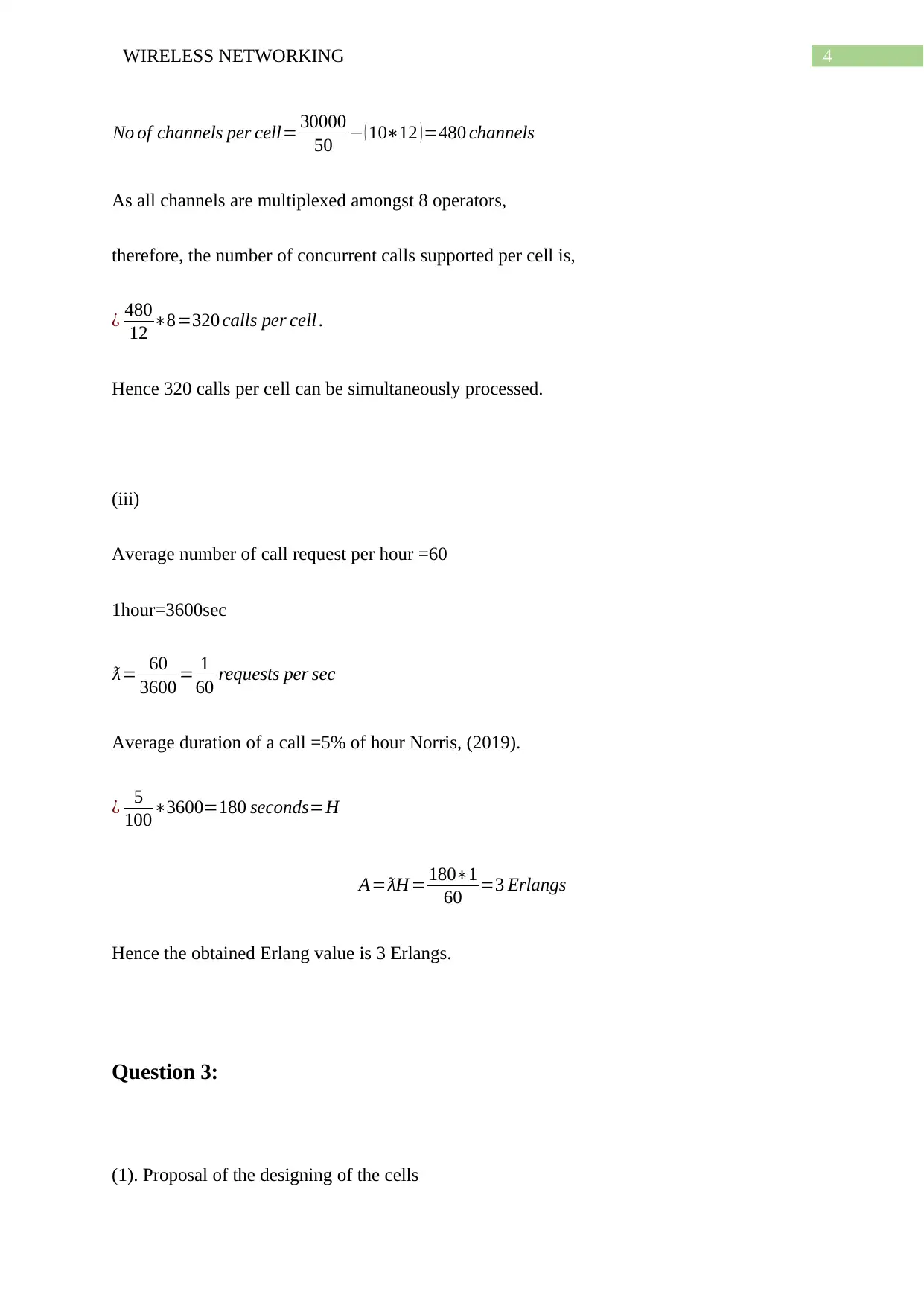
4WIRELESS NETWORKING
No of channels per cell= 30000
50 − ( 10∗12 )=480 channels
As all channels are multiplexed amongst 8 operators,
therefore, the number of concurrent calls supported per cell is,
¿ 480
12 ∗8=320 calls per cell .
Hence 320 calls per cell can be simultaneously processed.
(iii)
Average number of call request per hour =60
1hour=3600sec
ƛ= 60
3600 = 1
60 requests per sec
Average duration of a call =5% of hour Norris, (2019).
¿ 5
100∗3600=180 seconds=H
A=ƛH = 180∗1
60 =3 Erlangs
Hence the obtained Erlang value is 3 Erlangs.
Question 3:
(1). Proposal of the designing of the cells
No of channels per cell= 30000
50 − ( 10∗12 )=480 channels
As all channels are multiplexed amongst 8 operators,
therefore, the number of concurrent calls supported per cell is,
¿ 480
12 ∗8=320 calls per cell .
Hence 320 calls per cell can be simultaneously processed.
(iii)
Average number of call request per hour =60
1hour=3600sec
ƛ= 60
3600 = 1
60 requests per sec
Average duration of a call =5% of hour Norris, (2019).
¿ 5
100∗3600=180 seconds=H
A=ƛH = 180∗1
60 =3 Erlangs
Hence the obtained Erlang value is 3 Erlangs.
Question 3:
(1). Proposal of the designing of the cells
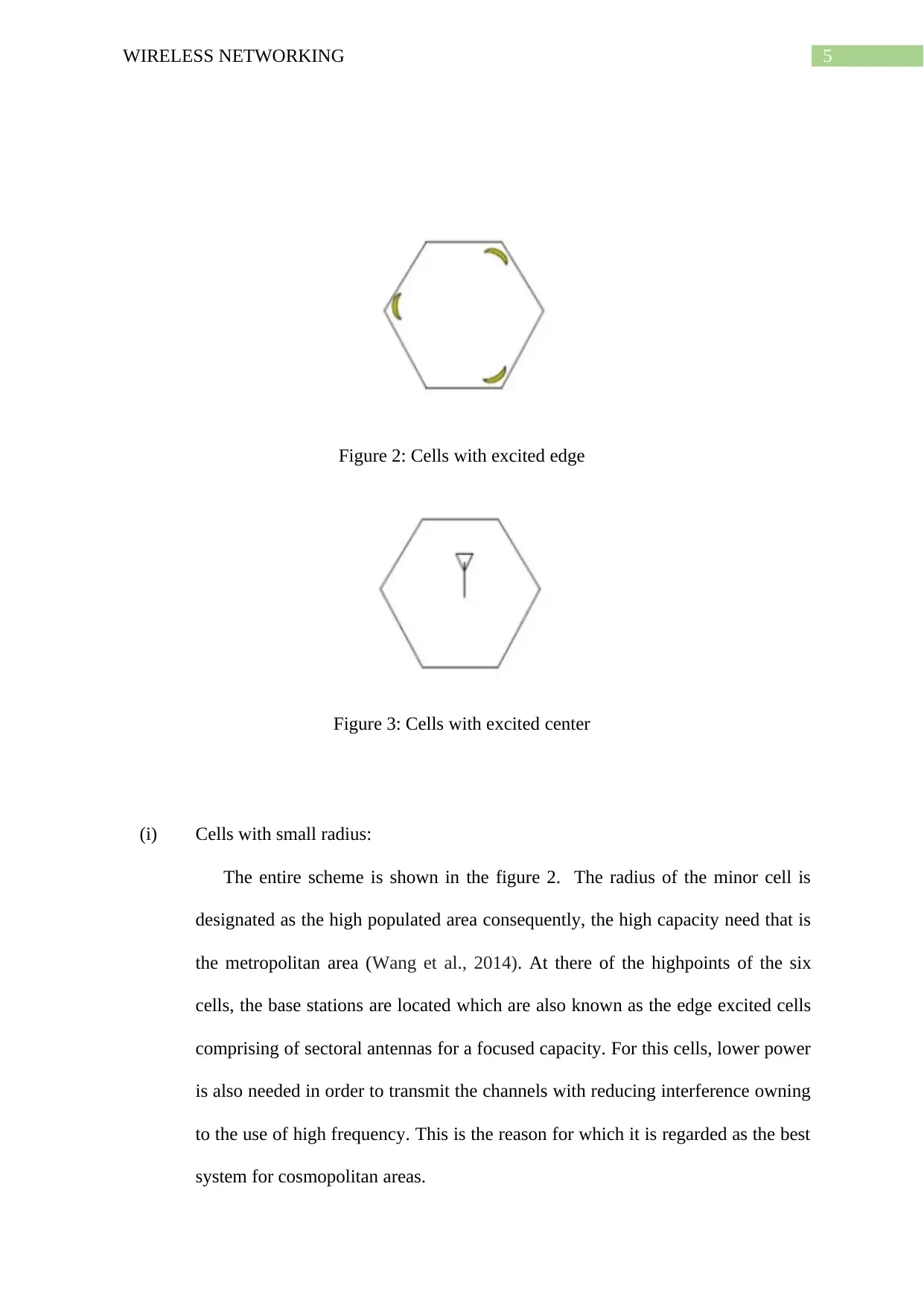
5WIRELESS NETWORKING
Figure 2: Cells with excited edge
Figure 3: Cells with excited center
(i) Cells with small radius:
The entire scheme is shown in the figure 2. The radius of the minor cell is
designated as the high populated area consequently, the high capacity need that is
the metropolitan area (Wang et al., 2014). At there of the highpoints of the six
cells, the base stations are located which are also known as the edge excited cells
comprising of sectoral antennas for a focused capacity. For this cells, lower power
is also needed in order to transmit the channels with reducing interference owning
to the use of high frequency. This is the reason for which it is regarded as the best
system for cosmopolitan areas.
Figure 2: Cells with excited edge
Figure 3: Cells with excited center
(i) Cells with small radius:
The entire scheme is shown in the figure 2. The radius of the minor cell is
designated as the high populated area consequently, the high capacity need that is
the metropolitan area (Wang et al., 2014). At there of the highpoints of the six
cells, the base stations are located which are also known as the edge excited cells
comprising of sectoral antennas for a focused capacity. For this cells, lower power
is also needed in order to transmit the channels with reducing interference owning
to the use of high frequency. This is the reason for which it is regarded as the best
system for cosmopolitan areas.
⊘ This is a preview!⊘
Do you want full access?
Subscribe today to unlock all pages.

Trusted by 1+ million students worldwide
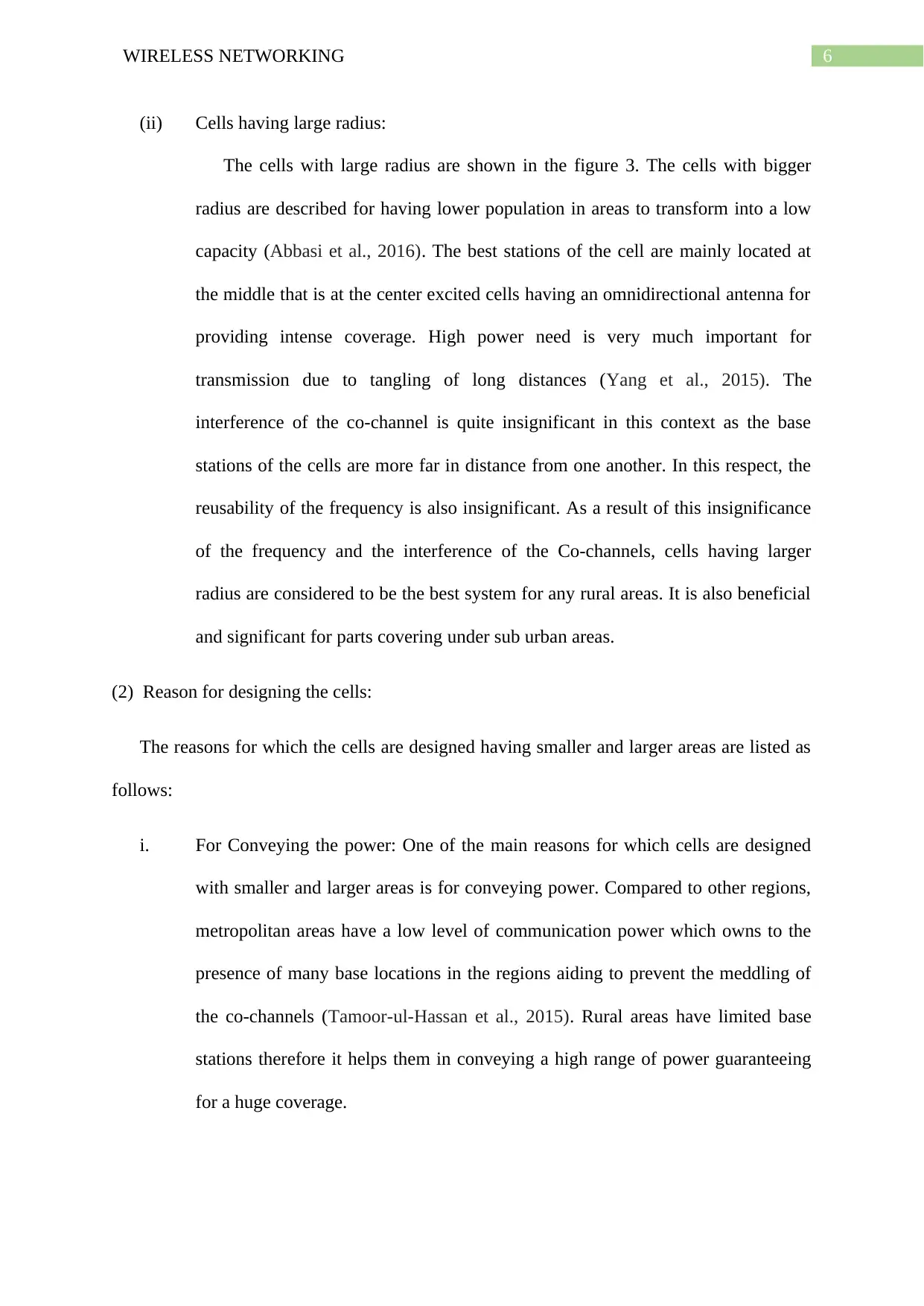
6WIRELESS NETWORKING
(ii) Cells having large radius:
The cells with large radius are shown in the figure 3. The cells with bigger
radius are described for having lower population in areas to transform into a low
capacity (Abbasi et al., 2016). The best stations of the cell are mainly located at
the middle that is at the center excited cells having an omnidirectional antenna for
providing intense coverage. High power need is very much important for
transmission due to tangling of long distances (Yang et al., 2015). The
interference of the co-channel is quite insignificant in this context as the base
stations of the cells are more far in distance from one another. In this respect, the
reusability of the frequency is also insignificant. As a result of this insignificance
of the frequency and the interference of the Co-channels, cells having larger
radius are considered to be the best system for any rural areas. It is also beneficial
and significant for parts covering under sub urban areas.
(2) Reason for designing the cells:
The reasons for which the cells are designed having smaller and larger areas are listed as
follows:
i. For Conveying the power: One of the main reasons for which cells are designed
with smaller and larger areas is for conveying power. Compared to other regions,
metropolitan areas have a low level of communication power which owns to the
presence of many base locations in the regions aiding to prevent the meddling of
the co-channels (Tamoor-ul-Hassan et al., 2015). Rural areas have limited base
stations therefore it helps them in conveying a high range of power guaranteeing
for a huge coverage.
(ii) Cells having large radius:
The cells with large radius are shown in the figure 3. The cells with bigger
radius are described for having lower population in areas to transform into a low
capacity (Abbasi et al., 2016). The best stations of the cell are mainly located at
the middle that is at the center excited cells having an omnidirectional antenna for
providing intense coverage. High power need is very much important for
transmission due to tangling of long distances (Yang et al., 2015). The
interference of the co-channel is quite insignificant in this context as the base
stations of the cells are more far in distance from one another. In this respect, the
reusability of the frequency is also insignificant. As a result of this insignificance
of the frequency and the interference of the Co-channels, cells having larger
radius are considered to be the best system for any rural areas. It is also beneficial
and significant for parts covering under sub urban areas.
(2) Reason for designing the cells:
The reasons for which the cells are designed having smaller and larger areas are listed as
follows:
i. For Conveying the power: One of the main reasons for which cells are designed
with smaller and larger areas is for conveying power. Compared to other regions,
metropolitan areas have a low level of communication power which owns to the
presence of many base locations in the regions aiding to prevent the meddling of
the co-channels (Tamoor-ul-Hassan et al., 2015). Rural areas have limited base
stations therefore it helps them in conveying a high range of power guaranteeing
for a huge coverage.
Paraphrase This Document
Need a fresh take? Get an instant paraphrase of this document with our AI Paraphraser
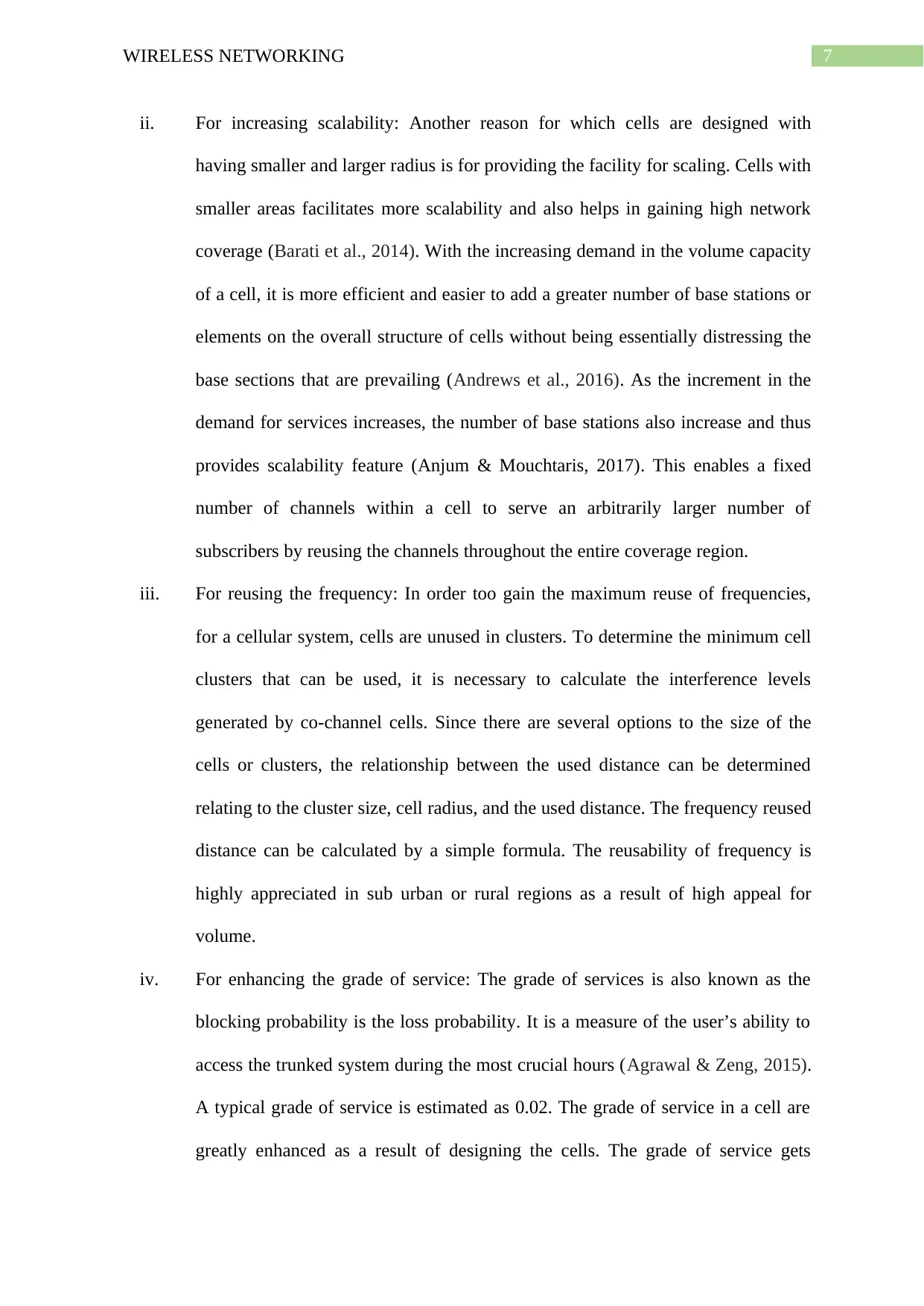
7WIRELESS NETWORKING
ii. For increasing scalability: Another reason for which cells are designed with
having smaller and larger radius is for providing the facility for scaling. Cells with
smaller areas facilitates more scalability and also helps in gaining high network
coverage (Barati et al., 2014). With the increasing demand in the volume capacity
of a cell, it is more efficient and easier to add a greater number of base stations or
elements on the overall structure of cells without being essentially distressing the
base sections that are prevailing (Andrews et al., 2016). As the increment in the
demand for services increases, the number of base stations also increase and thus
provides scalability feature (Anjum & Mouchtaris, 2017). This enables a fixed
number of channels within a cell to serve an arbitrarily larger number of
subscribers by reusing the channels throughout the entire coverage region.
iii. For reusing the frequency: In order too gain the maximum reuse of frequencies,
for a cellular system, cells are unused in clusters. To determine the minimum cell
clusters that can be used, it is necessary to calculate the interference levels
generated by co-channel cells. Since there are several options to the size of the
cells or clusters, the relationship between the used distance can be determined
relating to the cluster size, cell radius, and the used distance. The frequency reused
distance can be calculated by a simple formula. The reusability of frequency is
highly appreciated in sub urban or rural regions as a result of high appeal for
volume.
iv. For enhancing the grade of service: The grade of services is also known as the
blocking probability is the loss probability. It is a measure of the user’s ability to
access the trunked system during the most crucial hours (Agrawal & Zeng, 2015).
A typical grade of service is estimated as 0.02. The grade of service in a cell are
greatly enhanced as a result of designing the cells. The grade of service gets
ii. For increasing scalability: Another reason for which cells are designed with
having smaller and larger radius is for providing the facility for scaling. Cells with
smaller areas facilitates more scalability and also helps in gaining high network
coverage (Barati et al., 2014). With the increasing demand in the volume capacity
of a cell, it is more efficient and easier to add a greater number of base stations or
elements on the overall structure of cells without being essentially distressing the
base sections that are prevailing (Andrews et al., 2016). As the increment in the
demand for services increases, the number of base stations also increase and thus
provides scalability feature (Anjum & Mouchtaris, 2017). This enables a fixed
number of channels within a cell to serve an arbitrarily larger number of
subscribers by reusing the channels throughout the entire coverage region.
iii. For reusing the frequency: In order too gain the maximum reuse of frequencies,
for a cellular system, cells are unused in clusters. To determine the minimum cell
clusters that can be used, it is necessary to calculate the interference levels
generated by co-channel cells. Since there are several options to the size of the
cells or clusters, the relationship between the used distance can be determined
relating to the cluster size, cell radius, and the used distance. The frequency reused
distance can be calculated by a simple formula. The reusability of frequency is
highly appreciated in sub urban or rural regions as a result of high appeal for
volume.
iv. For enhancing the grade of service: The grade of services is also known as the
blocking probability is the loss probability. It is a measure of the user’s ability to
access the trunked system during the most crucial hours (Agrawal & Zeng, 2015).
A typical grade of service is estimated as 0.02. The grade of service in a cell are
greatly enhanced as a result of designing the cells. The grade of service gets
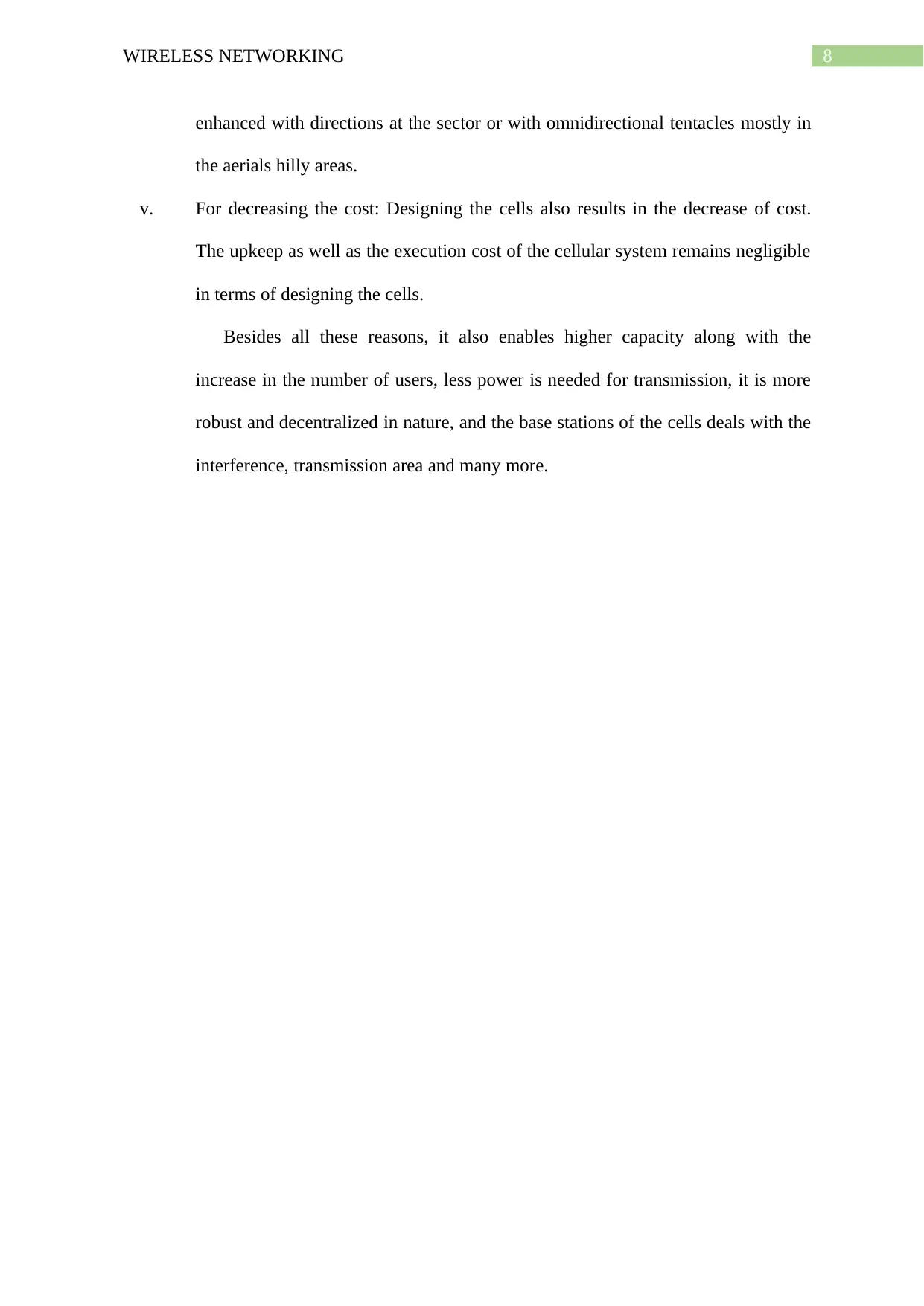
8WIRELESS NETWORKING
enhanced with directions at the sector or with omnidirectional tentacles mostly in
the aerials hilly areas.
v. For decreasing the cost: Designing the cells also results in the decrease of cost.
The upkeep as well as the execution cost of the cellular system remains negligible
in terms of designing the cells.
Besides all these reasons, it also enables higher capacity along with the
increase in the number of users, less power is needed for transmission, it is more
robust and decentralized in nature, and the base stations of the cells deals with the
interference, transmission area and many more.
enhanced with directions at the sector or with omnidirectional tentacles mostly in
the aerials hilly areas.
v. For decreasing the cost: Designing the cells also results in the decrease of cost.
The upkeep as well as the execution cost of the cellular system remains negligible
in terms of designing the cells.
Besides all these reasons, it also enables higher capacity along with the
increase in the number of users, less power is needed for transmission, it is more
robust and decentralized in nature, and the base stations of the cells deals with the
interference, transmission area and many more.
⊘ This is a preview!⊘
Do you want full access?
Subscribe today to unlock all pages.

Trusted by 1+ million students worldwide
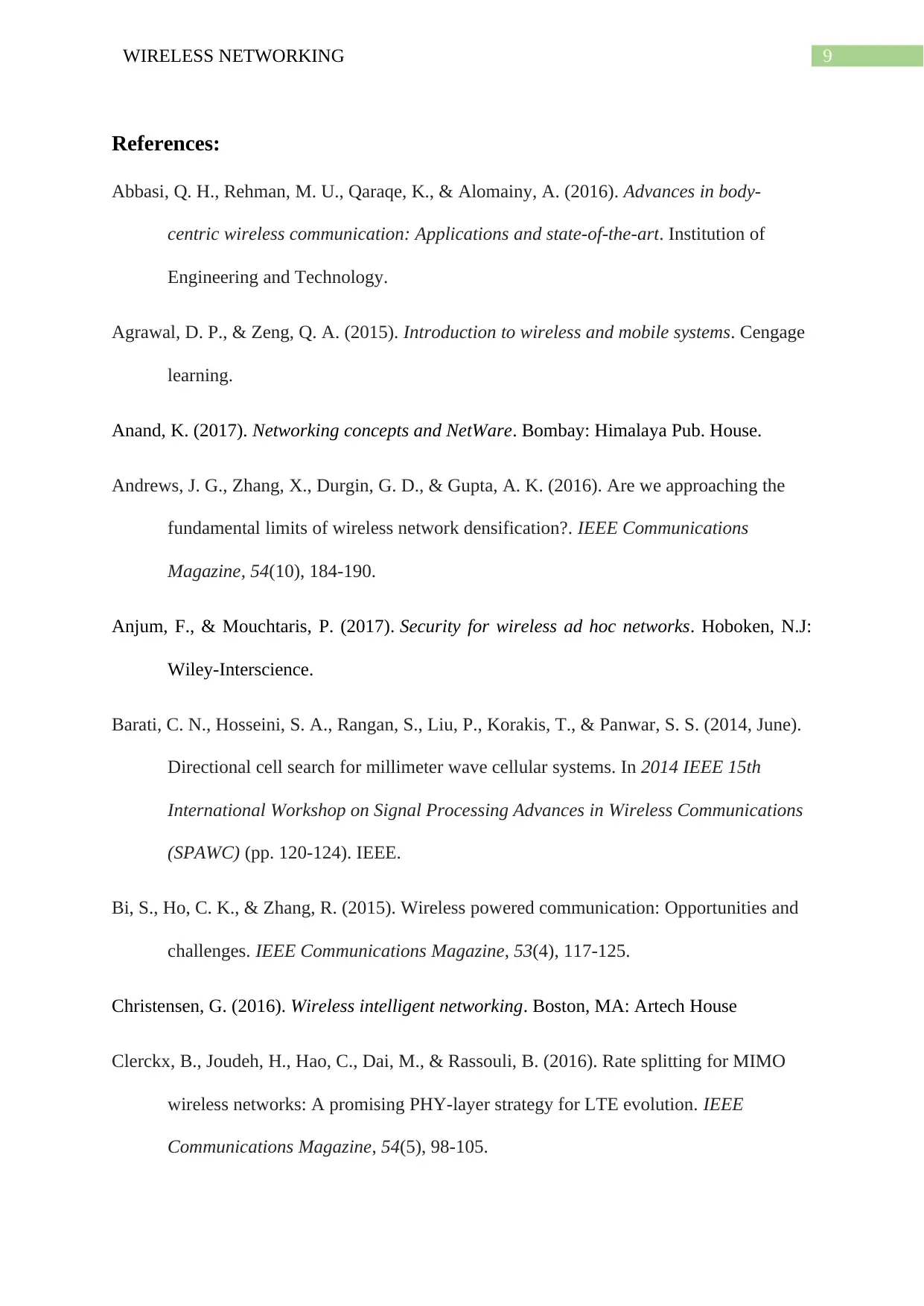
9WIRELESS NETWORKING
References:
Abbasi, Q. H., Rehman, M. U., Qaraqe, K., & Alomainy, A. (2016). Advances in body-
centric wireless communication: Applications and state-of-the-art. Institution of
Engineering and Technology.
Agrawal, D. P., & Zeng, Q. A. (2015). Introduction to wireless and mobile systems. Cengage
learning.
Anand, K. (2017). Networking concepts and NetWare. Bombay: Himalaya Pub. House.
Andrews, J. G., Zhang, X., Durgin, G. D., & Gupta, A. K. (2016). Are we approaching the
fundamental limits of wireless network densification?. IEEE Communications
Magazine, 54(10), 184-190.
Anjum, F., & Mouchtaris, P. (2017). Security for wireless ad hoc networks. Hoboken, N.J:
Wiley-Interscience.
Barati, C. N., Hosseini, S. A., Rangan, S., Liu, P., Korakis, T., & Panwar, S. S. (2014, June).
Directional cell search for millimeter wave cellular systems. In 2014 IEEE 15th
International Workshop on Signal Processing Advances in Wireless Communications
(SPAWC) (pp. 120-124). IEEE.
Bi, S., Ho, C. K., & Zhang, R. (2015). Wireless powered communication: Opportunities and
challenges. IEEE Communications Magazine, 53(4), 117-125.
Christensen, G. (2016). Wireless intelligent networking. Boston, MA: Artech House
Clerckx, B., Joudeh, H., Hao, C., Dai, M., & Rassouli, B. (2016). Rate splitting for MIMO
wireless networks: A promising PHY-layer strategy for LTE evolution. IEEE
Communications Magazine, 54(5), 98-105.
References:
Abbasi, Q. H., Rehman, M. U., Qaraqe, K., & Alomainy, A. (2016). Advances in body-
centric wireless communication: Applications and state-of-the-art. Institution of
Engineering and Technology.
Agrawal, D. P., & Zeng, Q. A. (2015). Introduction to wireless and mobile systems. Cengage
learning.
Anand, K. (2017). Networking concepts and NetWare. Bombay: Himalaya Pub. House.
Andrews, J. G., Zhang, X., Durgin, G. D., & Gupta, A. K. (2016). Are we approaching the
fundamental limits of wireless network densification?. IEEE Communications
Magazine, 54(10), 184-190.
Anjum, F., & Mouchtaris, P. (2017). Security for wireless ad hoc networks. Hoboken, N.J:
Wiley-Interscience.
Barati, C. N., Hosseini, S. A., Rangan, S., Liu, P., Korakis, T., & Panwar, S. S. (2014, June).
Directional cell search for millimeter wave cellular systems. In 2014 IEEE 15th
International Workshop on Signal Processing Advances in Wireless Communications
(SPAWC) (pp. 120-124). IEEE.
Bi, S., Ho, C. K., & Zhang, R. (2015). Wireless powered communication: Opportunities and
challenges. IEEE Communications Magazine, 53(4), 117-125.
Christensen, G. (2016). Wireless intelligent networking. Boston, MA: Artech House
Clerckx, B., Joudeh, H., Hao, C., Dai, M., & Rassouli, B. (2016). Rate splitting for MIMO
wireless networks: A promising PHY-layer strategy for LTE evolution. IEEE
Communications Magazine, 54(5), 98-105.
Paraphrase This Document
Need a fresh take? Get an instant paraphrase of this document with our AI Paraphraser
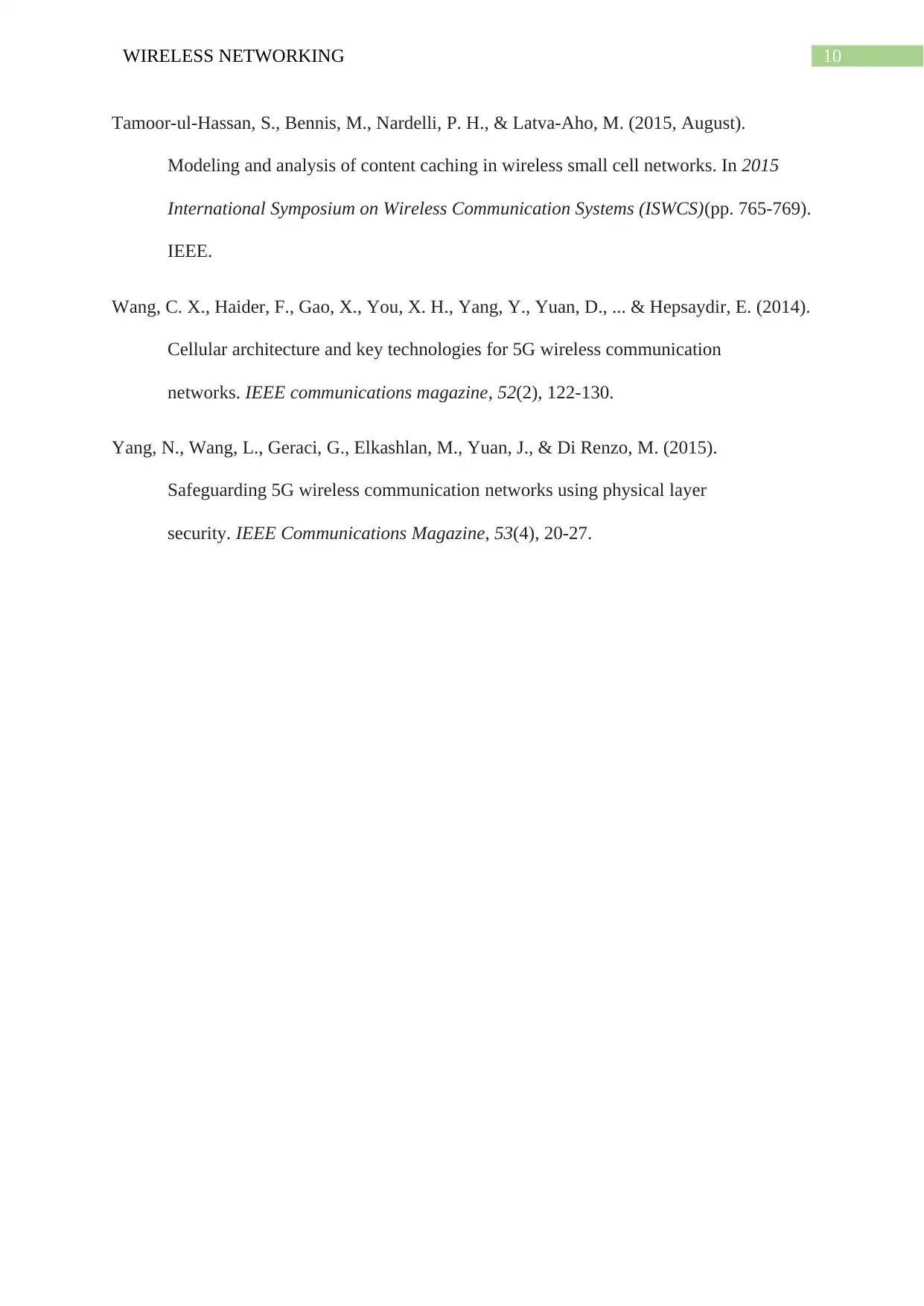
10WIRELESS NETWORKING
Tamoor-ul-Hassan, S., Bennis, M., Nardelli, P. H., & Latva-Aho, M. (2015, August).
Modeling and analysis of content caching in wireless small cell networks. In 2015
International Symposium on Wireless Communication Systems (ISWCS)(pp. 765-769).
IEEE.
Wang, C. X., Haider, F., Gao, X., You, X. H., Yang, Y., Yuan, D., ... & Hepsaydir, E. (2014).
Cellular architecture and key technologies for 5G wireless communication
networks. IEEE communications magazine, 52(2), 122-130.
Yang, N., Wang, L., Geraci, G., Elkashlan, M., Yuan, J., & Di Renzo, M. (2015).
Safeguarding 5G wireless communication networks using physical layer
security. IEEE Communications Magazine, 53(4), 20-27.
Tamoor-ul-Hassan, S., Bennis, M., Nardelli, P. H., & Latva-Aho, M. (2015, August).
Modeling and analysis of content caching in wireless small cell networks. In 2015
International Symposium on Wireless Communication Systems (ISWCS)(pp. 765-769).
IEEE.
Wang, C. X., Haider, F., Gao, X., You, X. H., Yang, Y., Yuan, D., ... & Hepsaydir, E. (2014).
Cellular architecture and key technologies for 5G wireless communication
networks. IEEE communications magazine, 52(2), 122-130.
Yang, N., Wang, L., Geraci, G., Elkashlan, M., Yuan, J., & Di Renzo, M. (2015).
Safeguarding 5G wireless communication networks using physical layer
security. IEEE Communications Magazine, 53(4), 20-27.
1 out of 11
Related Documents
Your All-in-One AI-Powered Toolkit for Academic Success.
+13062052269
info@desklib.com
Available 24*7 on WhatsApp / Email
![[object Object]](/_next/static/media/star-bottom.7253800d.svg)
Unlock your academic potential
Copyright © 2020–2025 A2Z Services. All Rights Reserved. Developed and managed by ZUCOL.





